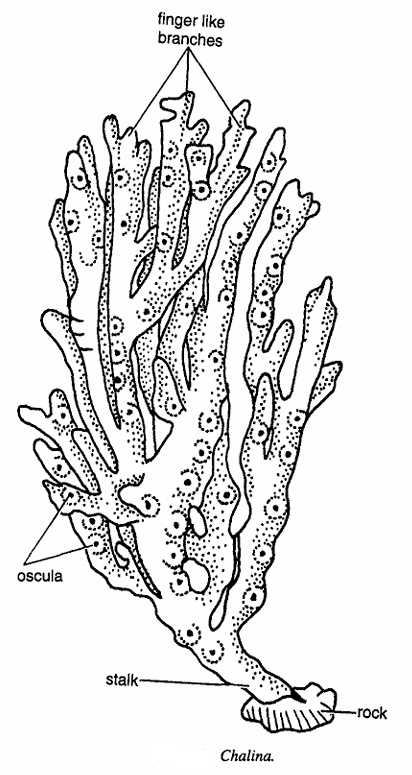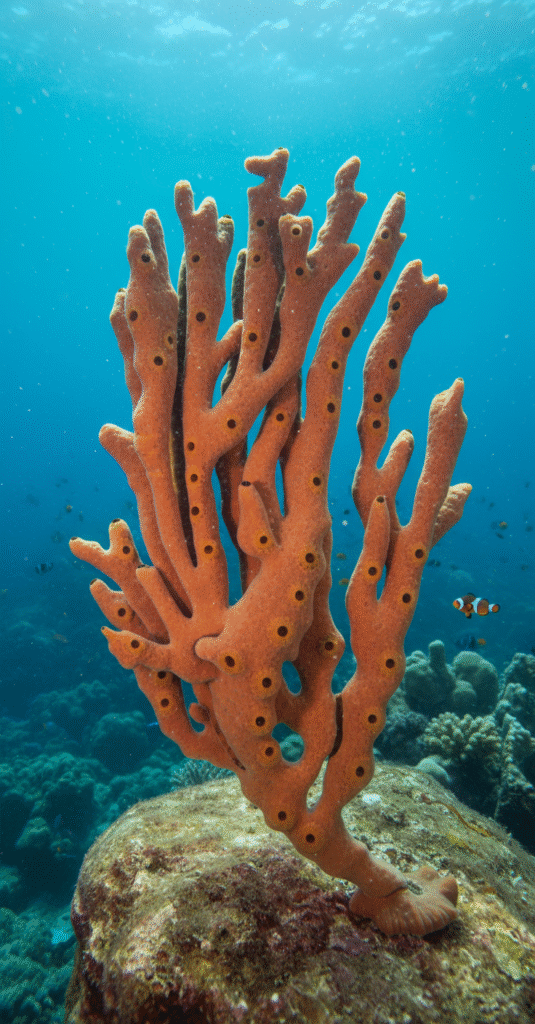Classification of Chalina
- Phylum: Porifera (Pore-bearing animals with a simple, cellular-grade body organization)
- Class: Demospongiae (Sponges with skeletons of spongin fibers, sometimes reinforced with siliceous spicules)
- Order: Haplosclerida (Sponges with a predominantly reticulate skeleton formed by spongin and siliceous oxeas)
- Family: Chalinidae (Typically thinly encrusting or finger-like sponges with elastic, soft textures and simple canal systems)
- Genus: Chalina
Famously known as the finger sponge, is a branched marine sponge that inhabits shallow sea zones and coastal areas.

Habit and Habitat
Chalina species prefer rocky substrates and coral reefs, where they attach themselves firmly to solid surfaces. They are most commonly found in shallow subtidal and intertidal zones, but can also be seen in deeper, colder habitats and sometimes even in mangrove forests. The finger sponge favors gently moving waters that provide steady access to floating organic matter, which it filters for food.
Geographical Distribution
Chalina sponges are widely distributed throughout the world’s oceans but are especially prevalent in the North Atlantic, extending from the Rhodes Islands to the coast of Portugal, and present in European waters as well as other temperate and tropical marine environments. They are a common sight along the subtidal zones of Europe, the British Isles, and North America.
General Characteristics
- Chalina is commonly called as Dead man’s fingers or Mermaid’s gloves.
- Orange or yellowish-brown or red-coloured sponge attached to rocks by stalk.
- Surface of the body is flattened consisting of bunches of finger-like branches and perforated by several ostia and several oscula.
- Skeleton comprise spongin and siliceous spicules. It may be joined or enclosed.
- Canal system is of leucon type.
- It reproduces sexually and asexually by regeneration and budding. Sexual reproduction by sperm and ova
- The body is highly branched, soft, and finger-like, often with an orange-red or yellow-brown coloration.
- Branches are somewhat flattened and perforated by multiple oscula (large openings), easily seen along each “finger.”
- The skeleton consists mostly of spongin fibers interspersed with slim siliceous monaxon spicules known as oxeas.
- Surface is velvety or may feel slightly viscous to the touch, with a flexible and compressible consistency.
- The canal system is of the leucon type, making water filtration efficient for nutrient capture.
- Reproduction occurs both sexually (hermaphroditic, producing larval forms) and asexually via regeneration or budding.
- Some species produce bioactive compounds of potential pharmaceutical interest.

Special Features
One distinct feature of the Chalina genus is its slender, elongated, and highly branched structure, which maximizes surface area for filter feeding and provides shelter for small aquatic organisms. The resilience and regenerative power of Chalina also allow it to thrive in variable marine conditions and repair itself from injury or predation.
Identification
The animal has finger shaped, forked or digitate stalk shaped body, ostia and all above characters and hence, it is Chalina.
It is easily recognized by its finger-like, highly branched body attached to rocks or coral. The vivid coloration, abundance of oscula, and soft, flexible structure help distinguish it from more massive or encrusting sponges. Its spongin and siliceous oxeas-based skeleton and visible leuconoid canal system also reinforce its identity.
References:
- https://www.biologydiscussion.com/structures/structure-of-finger-sponge-chalina-with-diagram-zoology/60477
- http://www.marinespecies.org/porifera/porifera.php?p=sourceget&id=9061
- https://www.youtube.com/watch?v=XdmxybydF24
- https://en.wikipedia.org/wiki/Chalinidae
- http://invertebratezoologycollection.weebly.com/chalina.html
- https://byjus.com/neet/cliona/
- https://www.askiitians.com/forums/10-grade-science/chalina-is-commonly-known-as-a-finger-sponge-b-d-25_476847.htm
- http://www.marinespecies.org/aphia.php?p=taxdetails&id=150245
- https://www.vedantu.com/question-answer/chalina-is-commonly-known-as-a-finger-sponge-b-class-10-biology-cbse-5f7dc0ca6f1c2b70cf938f65
- https://www.biologydiscussion.com/invertebrate-zoology/sponges/sponges-characters-classification-and-types-zoology/28518
